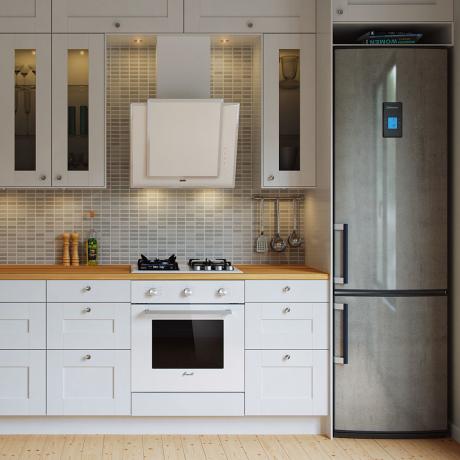Content
-
1 Kitchen hood operation
- 1.1 Work principles
- 1.2 Air vent or filter
-
2 Hood filters
- 2.1 Coarse filters
- 2.2 Fine filters
-
3 Hood care
- 3.1 Cleaning the filters
- 3.2 Replacing the charcoal filter
The kitchen is the room that needs the most efficient air purification. This is why kitchen hoods with a charcoal filter are so popular today, because with the right selection and installation, such hood can provide you with clean air while you are cooking. In this case, we are talking not only about untidy odors - after all, carbon filters also remove fumes and soot from the air, and the anti-grease filter included in the kit captures drops of fat emulsion.

Cooker hood with charcoal filter
At the same time, the choice of the hood is associated with some nuances, therefore, before installing this invention, we follow as closely as possible to familiarize ourselves with the principles by which it works.
Read also the material on the site: How to choose a hood for the kitchen: the question on which the air purity depends.
Kitchen hood operation
Work principles
Today on the market of household appliances for kitchens there are many different models of hoods.
They differ in both design and performance, but if we talk about the principles of operation of these devices, then they can be divided into two large categories:
- Air vent hoods. These hoods are connected to the ventilation ducts of the building, and with the help of electric motors remove air from the kitchen into the ventilation. For the efficient operation of the exhaust type hood, it is necessary for the ventilation system of the building to function properly, as well as to ensure the flow of air.
Read more about this in the article Hood for the kitchen with an air duct: varieties and installation.
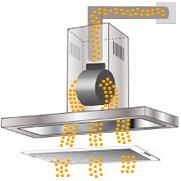
The principle of operation of the exhaust hood
Advice! To ensure the flow of air to the operating hood, set the kitchen window to ventilation mode or do not close the kitchen door too tightly.
- Filtering (recirculating) hoods do not remove air from the kitchen. Taking hot and dirty air from the space above the stove, they "let it pass through themselves." A charcoal filter for a kitchen hood helps to remove impurities and unpleasant odors from the air - and we get purified air at the outlet!
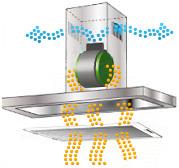
How the hood works with a charcoal filter
The advantages of filter hoods are obvious: they do not care about the condition of the ventilation ducts or the placement of the strap for connection. And yet, today the discussion about which is better - a kitchen hood with a charcoal filter or an air extraction hood - is very active.
Air vent or filter
Choosing between an exhaust and recirculating hood is a difficult task. The thing is that it is the air-vent design of the hood that is classic, and the hoods with filters that are sufficiently effective to ensure air purification at the required level have appeared relatively recently.

Compact recirculation hood
However, there are several quite weighty arguments in favor of filter-type hoods:
- Firstly, the efficiency with which the cooker hoods with a charcoal filter for the kitchen work is absolutely independent of the ventilation state of the task. Even if you have clogged strangleholds, and housing and maintenance services cannot attend to cleaning them for a year, your kitchen will have clean air!
- Since such a hood does not need an air duct and a large dome for efficient operation, it can be quite compact in size. You can install a small model 50 cm wide in the kitchen - and it will be enough!
- For the operation of such a product, forced ventilation is not required, so in winter you will not be forced to freeze.
- As a rule, the price of both the filtering hoods themselves and the consumables (i.e. the filters themselves) is quite affordable (see. article Choosing a filter for a kitchen hood)
- Replacing filters is also not particularly difficult. To complete it, you don't even need to call specialists - the filters are replaced with your own hands in just a couple of minutes.
Note! In addition, the installation of the recirculation hood takes much less time - after all, there is no need to deal with laying the air duct to the nearest ventilation duct, fixing it and masking it.
Hood filters
Coarse filters
Recirculating hoods, as a rule, are equipped with two types of filters - anti-grease and charcoal. To understand how to properly care for such a hood and how to make it work as efficiently as possible, we will consider each of them in detail.

Anti-grease filter before and after cleaning
Anti-grease filters for kitchen hoods are filters that are responsible for coarse air purification:
- Such a filter captures droplets of fat suspended in the air (hence the name), particles of soot, soot, dust, etc.
- An anti-grease filter is installed "at the inlet" of the hood and protects the motor and fan blades from grease.
- The efficiency of anti-grease filters is more than 95%, which means that after passing through the filter, there are practically no large impurities in the air.
Anti-grease filters can be either disposable or reusable.
- The disposable grease filters for cooker hoods are made from cloth plates. For their production, synthetic fiber is most often used - non-woven, synthetic winterizer, acrylic, etc. Most often, disposable grease filters are used in inexpensive suspended hoods.
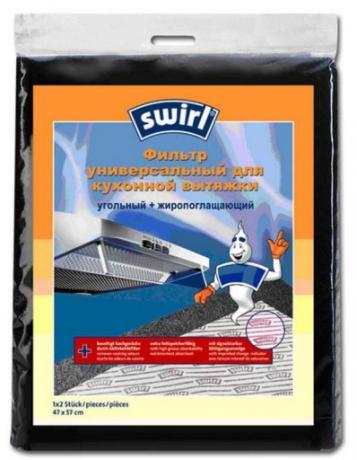
Grease cloth filter
Note! On the Internet, you can sometimes find tips for restoring anti-grease filters (in other words, for their proper washing). This is not worth doing, since a grease filter that has gone through this procedure loses a significant part of its effectiveness.
The reusable grease filter is most often a small-mesh metal mesh cassette (pictured). The grease filter cassette is also filled with perforated foil, galvanized steel or anodized aluminum.
These filters are preferable because they do not oxidize due to the protective coating on the metal.

Reusable grease filter
If you choose a hood, then preference should be given to models with reusable coarse filters. These filters are not inferior to fabric filters in terms of efficiency, but they surpass them in practicality. Replacement of the reusable filter is not required - it is enough to periodically remove and wash it.
Fine filters
For a finer purification of the air, and most importantly - to remove unpleasant odors from it, a charcoal filter is placed behind the grease filter.
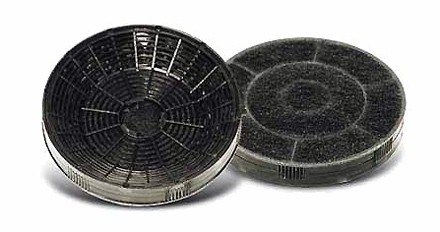
Cassette carbon filter
Note! Sometimes these filters are called "absorption" or "anti-odor".
The structure of the carbon filter is as follows:
- The design is based on a round plastic cassette or a rectangular cartridge.
- Inside the filter housing there is carbon itself in the form of powder or fine granules.
- To prevent spillage, the carbon absorbent is covered with a fine mesh.
During the operation of the hood, the air, under the influence of the engine, is forced through the carbon filter, leaving on it fine impurities, gases and unpleasant odors.
Over time, the density of the charcoal filter increases and therefore the charcoal filters in the hood must be replaced every three to four months. Some models of hoods are equipped with a special "reminder" - a sensor that shows when the filters begin to lose their capacity.

How the filter works
Advice! To prolong the effective life of the charcoal filter, let the hood run 5-10 minutes longer after all kitchen work is completed. Clean air passing through the charcoal filter removes excess moisture from it, which means that the charcoal will less cake and retain its filtering ability longer.
Both the anti-grease filter and the carbon filter work together to clean the air - which is why they need to be looked after, cleaned and replaced in a timely manner.
Hood care
Cleaning the filters
A cooker hood with a charcoal filter for the kitchen requires proper care - then it will last you much longer and will work more efficiently. Therefore, if you notice that the quality of air purification by the hood has decreased, it is time to start maintenance work.
Caring for the hood includes only two steps:
- Cleaning the grease filter;
- Replacement of carbon filters.
We clean the grease filter as follows:

Washing the anti-grease filter
- We take out the filter from the hood mounts and place it either in the bathroom or in a basin of a suitable size.
- Fill the filter with detergent (preferably with a pronounced anti-grease effect) and clean it thoroughly with a brush. Pour boiling water over the filter. If the pollution was not too strong, it should be enough!
- If the dishwashing detergent does not help, soak the filter in a hot solution of laundry soap and soda (two tablespoons per bar of soap) and leave it for 3-4 hours.
- The next most effective way is to treat the filter with a pipe cleaner. In this case, the instructions for this tool will help you choose the correct proportions for the solution, and the treatment itself should be carried out only in a stainless container.
After all cleaning activities, the grease filter must be rinsed and dried. Install the dried cartridge into the hood - you can use it!
Replacing the charcoal filter
Unlike a grease filter, coal cannot be cleaned; at most, they can be processed with a vacuum cleaner. But if the term of use has already come to an end, the filter needs to be changed.
This is done like this:

Removing the grease filter
- Disconnect the hood from the mains, pull out the plug from the socket. This is done in order to avoid accidentally turning on the electric motor.
- We remove the anti-grease filters.
- We take a cassette with a spent carbon filter and pull it out of the case. We take out the spent carbon filter from the cassette.
- We take a new carbon filter, insert it into the cassette. We close the cassette and insert it into the mounts on the hood. As a rule, a characteristic click indicates that the cassette is installed correctly.
- We return the anti-grease filter to its place.
- We turn on the hood and check its performance. We pay special attention to the absence of extraneous noise and vibrations - they can occur if we have installed the cassette incorrectly or fixed it with insufficient quality.

Insert cassette
As you can see, replacing the filters is easy. Moreover, there are a sufficient number of videos on the network that clearly demonstrate the replacement procedure - therefore, you should not have any difficulties at this stage.
So, a cooker hood with a charcoal filter is a rather efficient and not very demanding device to maintain. That is why we recommend that you pay attention to this type of device - it is quite possible that such a range hood is ideal for your kitchen!
